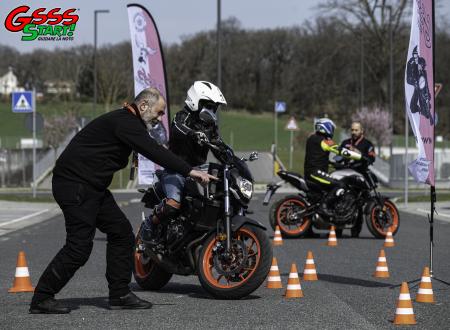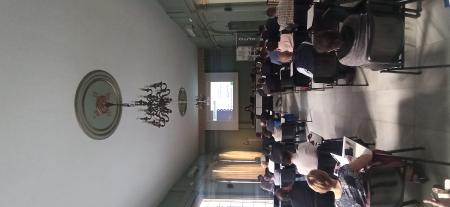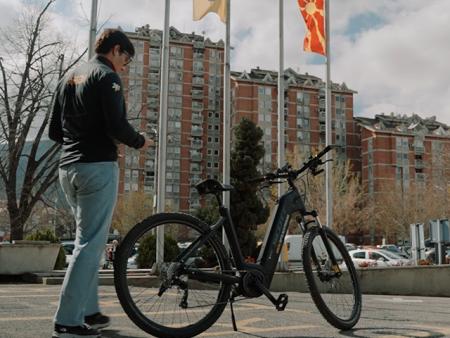Our members are dedicated to improving road safety and sharing their knowledge with the wider community. Here, you can explore our members' good practices – initiatives that have been assessed for their effectiveness in addressing a road safety problem and have proven results.
Get inspired – and sign up to share your good practices too!

Monday, June 3, 2024
DEKRA Italia, as a leading road safety company, faces several challenges and problems to raise awareness of the issue and reduce the number of accidents and deaths. One of the main ones is the increasing presence of driving distractions, such as cell phone use or lack of attention to the road due to fatigue or stress.
Our daily commitment is to raise awareness about the consequences of these bad habits and to promote responsible driving behavior.
In Italy in particular in the last year, there is a high number of road accidents especially among the younger generations: in this sense, our Mission is to raise awareness on proper road education among the youngest, but also aiming to include all age groups in order to change their cultural asset, values and habits in order to support the growth of a generation of future drivers inspired by safety and sustainability. By 'playing' from an early age with road safety and proactively exercising young people on the golden rules of safe driving, we are sure to contribute to future drivers being ready for the challenges on safety and sustainability of the cities of the future, between micro- and macro-mobility.
Our daily commitment is to raise awareness about the consequences of these bad habits and to promote responsible driving behavior.
In Italy in particular in the last year, there is a high number of road accidents especially among the younger generations: in this sense, our Mission is to raise awareness on proper road education among the youngest, but also aiming to include all age groups in order to change their cultural asset, values and habits in order to support the growth of a generation of future drivers inspired by safety and sustainability. By 'playing' from an early age with road safety and proactively exercising young people on the golden rules of safe driving, we are sure to contribute to future drivers being ready for the challenges on safety and sustainability of the cities of the future, between micro- and macro-mobility.

Wednesday, May 29, 2024
We have created a School for Motorcyclists called GSSS in 2005 to avoid head-on accidents occurring mostly in our wonderful Mountain contests. We have implemented a precise Method base on theoretical + practical lessons. We implemented a complete learning path that leads Students from basic teachings to advanced learnings.

Tuesday, May 28, 2024
La mayoría de la ciudadanía desconoce aspectos relacionados con los riesgos del ferrocarril y el uso seguro de los entornos ferroviarios. En el caso de los pasos a nivel, intersecciones entre la carretera y la infraestructura ferroviaria, tanto la población que conduce cualquier tipo de vehículo, como la que va a pie o tiene movilidad reducida, no conocen cómo funcionan o cómo cruzarlos con seguridad.
Este desconocimiento puede ser la causa por la que, desde 2010, de media, todos los días muere una persona en los pasos a nivel europeos. En España murieron 90 personas y 43 sufrieron heridas graves (2010-2022). Es verdad que el número de siniestros en carretera es superior, sin embargo, los que se producen en el ferrocarril tienen un impacto social mayor.
El número de víctimas mortales en accidentes ferroviarios en Europa ha disminuido, excepto los relacionados con pasos a nivel. Las estrategias para reducir la siniestralidad se han centrado fundamentalmente en introducir mejoras en las infraestructuras. No obstante, los datos de siniestralidad evidencian la necesidad de seguir impulsando actuaciones.
‘PaXando a Nivel’ pretende difundir buenas prácticas de seguridad informando sobre los diferentes tipos de pasos a nivel, sus componentes y funcionamiento, y su uso correcto.
Este desconocimiento puede ser la causa por la que, desde 2010, de media, todos los días muere una persona en los pasos a nivel europeos. En España murieron 90 personas y 43 sufrieron heridas graves (2010-2022). Es verdad que el número de siniestros en carretera es superior, sin embargo, los que se producen en el ferrocarril tienen un impacto social mayor.
El número de víctimas mortales en accidentes ferroviarios en Europa ha disminuido, excepto los relacionados con pasos a nivel. Las estrategias para reducir la siniestralidad se han centrado fundamentalmente en introducir mejoras en las infraestructuras. No obstante, los datos de siniestralidad evidencian la necesidad de seguir impulsando actuaciones.
‘PaXando a Nivel’ pretende difundir buenas prácticas de seguridad informando sobre los diferentes tipos de pasos a nivel, sus componentes y funcionamiento, y su uso correcto.

Tuesday, May 28, 2024
In the vision of becoming a cycling-friendly city, the City of Skopje invests massively in new and renovated cycling paths. Only last year, 40 kilometers of cycling paths in the city were opened, but due to a lack of expertise, they are with many flaws. As a result, the main focus of the project proposal is to increase the safety of bike commuters by providing independent assessments of the safety and quality of cycling infrastructure using the CycleRAP methodology. This is important for mobility planners and decision makers to understand the cycling infrastructure safety and develop investment plans that are evidence-based. In cooperation with the Factual, accredited partner and Advisory Board member of CycleRAP, we will not only provide safety assessment of the cycling infrastructure based on the CycleRAP methodology, but we will also provide evidence – based recommendations for increasing the safety of the cycling paths, while providing capacity building at the same time.

Tuesday, May 21, 2024
Die Zahl der Unfalltoten in Deutschland sank in den Pandemiejahren 2020/21 um 596 auf einen Tiefststand. Das ist ein Minus von 20 Prozent. Die Zahl der toten Insassen von Güterkraftfahrzeugen stieg hingegen in diesem Zeitabschnitt um 60 Prozent auf 70 tote Fahrer. Der überwiegende Teil starb auf hoch belasteten Transitrouten an Stauenden vor Dauerbaustellen zu Spitzenverkehrszeiten.
Wir wissen wo die Todesgefahr lauert. Wir wissen, zu welchen Zeiten sie erhöht ist. Wir wissen, warum es zum Unfall kommt und wir wissen, dass die Ursachen für den Unfalltod fast ausschließlich in der Ablenkung oder dem Sekundenschlaf zu suchen sind, weil der tödliche Einschlag ungebremst, also mit Anlauf und der Wucht von 40 Tonnen erfolgt.
Sofort beenden kann das Sterben nur einer: der Fahrer!
Vielen fehlt es jedoch an einem vitalen Gefahrenradar. Es herrscht ein europaweites Fortbildungsdefizit hinsichtlich der Unfallrisiken, als auch hinsichtlich der Wirkungsweisen der im LKW verbauten Assistenzsysteme.
Die Max Achtzig Idee stellt eine mehrsprachige illustrierte Aufklärungsbroschüre zu den mit Fahrern erarbeiteten 10 Max Achtzig Regeln und das Fachbuch "Max Achtzig - 40 Tonnen Verantwortung" (auch als Ebook in deutsch und englisch) in den Mittelpunkt, die den Fahrer gezielt aufklären und sein Gefahrenradar schärfen..Die Regeln sind Bestandteil des Max Achtzig Sicherheitsregisters für die Fahrerhandbücher der Transportunternehmen, welches in die Firmenphilosophie implementiert unfallreduzierend wirkt.
Aber der Fahrer braucht Rückhalt im Unternehmen, in Industrie und Handel, in der Politik und letztendlich auch in der Gesellschaft. Die Versorgung mit Gütern und die logistische Lieferkette können auch
reißen. Ihr stärkstes, aber gleichzeitig schwächstes Glied ist der Fahrer. Er braucht Wertschätzung, aber auch das unmissverständlich vermittelte Bewusstsein, dass er 40 Tonnen Verantwortung transportiert.
Unternehmen mit sozialer Nachhaltigkeit sind geeigneter, Stressoren für die Fahrer zu beseitigen. Sie können darüber hinaus mit der Einführung eines digitalen Rampenmanagements flexibler und damit für den Fahrer stressfreier Zeitfenster für Ladetätigkeiten managen.
Flankierend sind intelligente Stauwarner, wie bspw. C-ITS, weiter zu entwickeln..
Die Straßenbaulastträger müssen bei Einrichtung von Dauerbaustellen auf hoch belasteten Transitrouten den Einsatz von intelligenten, umsetzbaren Stauwarnanlagen als Standard planen, um den Verkehrsteilnehmer in Echtzeit vor einem Stauende zu warnen. Dazu müssen die Daten in der Mobilithek des BMDV Providern auch zur Verfügung gestellt unds abgerufen werden.
Es sterben Deutsche, wie internationale Fahrer. Bei dem zunehmenden Fahrermangel sollten sich alle an der Supply Chain Beteiligten verpflichtet fühlen, die Max Achtzig Idee zu übernehmen und das Motto der Kampagne verinnerlichen:
Es ist Zeit für Veränderung – Zeit am Leben zu bleiben.
Wir wissen wo die Todesgefahr lauert. Wir wissen, zu welchen Zeiten sie erhöht ist. Wir wissen, warum es zum Unfall kommt und wir wissen, dass die Ursachen für den Unfalltod fast ausschließlich in der Ablenkung oder dem Sekundenschlaf zu suchen sind, weil der tödliche Einschlag ungebremst, also mit Anlauf und der Wucht von 40 Tonnen erfolgt.
Sofort beenden kann das Sterben nur einer: der Fahrer!
Vielen fehlt es jedoch an einem vitalen Gefahrenradar. Es herrscht ein europaweites Fortbildungsdefizit hinsichtlich der Unfallrisiken, als auch hinsichtlich der Wirkungsweisen der im LKW verbauten Assistenzsysteme.
Die Max Achtzig Idee stellt eine mehrsprachige illustrierte Aufklärungsbroschüre zu den mit Fahrern erarbeiteten 10 Max Achtzig Regeln und das Fachbuch "Max Achtzig - 40 Tonnen Verantwortung" (auch als Ebook in deutsch und englisch) in den Mittelpunkt, die den Fahrer gezielt aufklären und sein Gefahrenradar schärfen..Die Regeln sind Bestandteil des Max Achtzig Sicherheitsregisters für die Fahrerhandbücher der Transportunternehmen, welches in die Firmenphilosophie implementiert unfallreduzierend wirkt.
Aber der Fahrer braucht Rückhalt im Unternehmen, in Industrie und Handel, in der Politik und letztendlich auch in der Gesellschaft. Die Versorgung mit Gütern und die logistische Lieferkette können auch
reißen. Ihr stärkstes, aber gleichzeitig schwächstes Glied ist der Fahrer. Er braucht Wertschätzung, aber auch das unmissverständlich vermittelte Bewusstsein, dass er 40 Tonnen Verantwortung transportiert.
Unternehmen mit sozialer Nachhaltigkeit sind geeigneter, Stressoren für die Fahrer zu beseitigen. Sie können darüber hinaus mit der Einführung eines digitalen Rampenmanagements flexibler und damit für den Fahrer stressfreier Zeitfenster für Ladetätigkeiten managen.
Flankierend sind intelligente Stauwarner, wie bspw. C-ITS, weiter zu entwickeln..
Die Straßenbaulastträger müssen bei Einrichtung von Dauerbaustellen auf hoch belasteten Transitrouten den Einsatz von intelligenten, umsetzbaren Stauwarnanlagen als Standard planen, um den Verkehrsteilnehmer in Echtzeit vor einem Stauende zu warnen. Dazu müssen die Daten in der Mobilithek des BMDV Providern auch zur Verfügung gestellt unds abgerufen werden.
Es sterben Deutsche, wie internationale Fahrer. Bei dem zunehmenden Fahrermangel sollten sich alle an der Supply Chain Beteiligten verpflichtet fühlen, die Max Achtzig Idee zu übernehmen und das Motto der Kampagne verinnerlichen:
Es ist Zeit für Veränderung – Zeit am Leben zu bleiben.